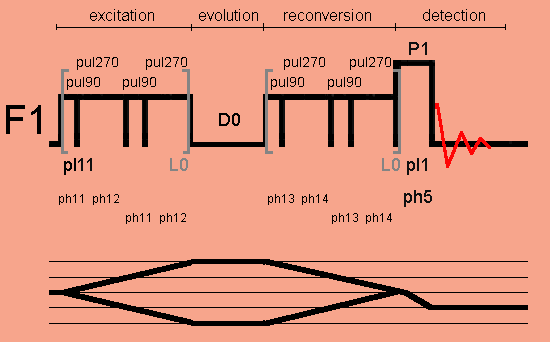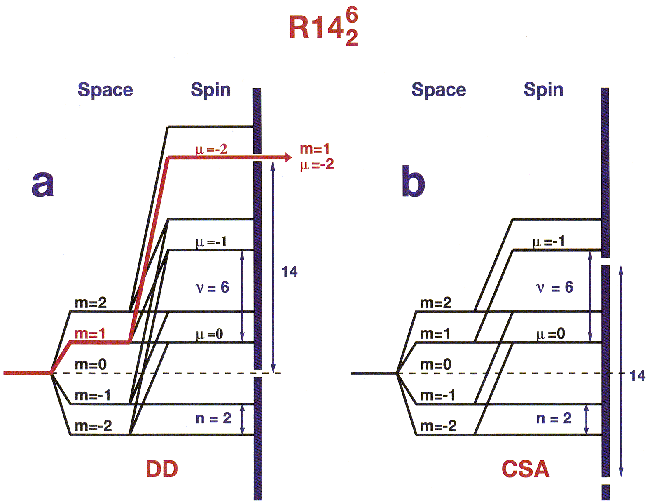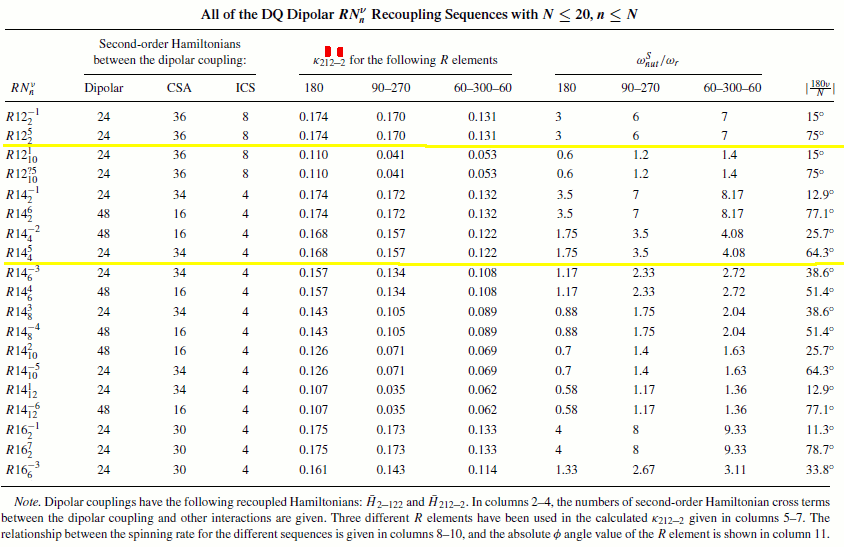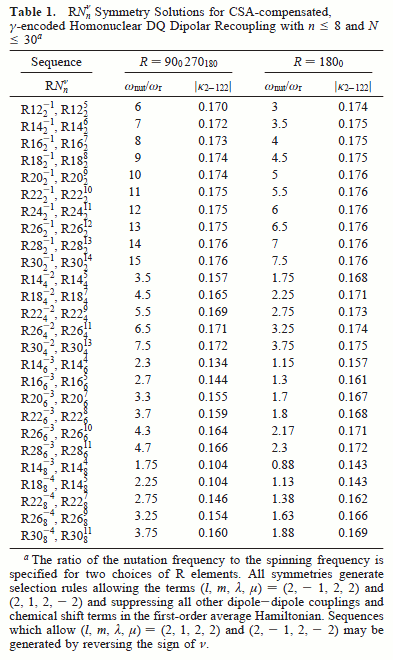
R14_2^6bsw-2d: 2D big double-quantum F1 spectral width R1426 pulse program for TopSpin2.1

Since non-phase cycling is applied to the R14_2^6 excitation pulse, four-phase cycling is applied to the detection pulse P1 for selecting the 0Q -> -1Q coherence order jump, and four-phase cycling is applied to the R14_2^6 reconversion pulse for filtering DQ coherences.

Figure 1: Space-spin selection diagram for R1426. Terms are indicated by branching pathways. The vertical wall on the right-hand side of the diagrams represents the first-order selection rule. Pathways with m < 0 and μ < 0 have been omitted for simplicity. (a) SSS diagram for the homonuclear dipole-dipole coupling (l, λ) = (2, 2). (b) SSS diagram for the chemical shift anisotropy (l, λ) = (2, 1)
M. Carravetta, M. Edén, O. G. Johannessen, H. Luthman, P. J. E. Verdegem, J. Lugtenburg, A. Sebald, and M. H. Levitt, Estimation of carbon-carbon bond lengths and medium-range internuclear distances by solid-state nuclear magnetic resonance, J. Am. Chem. Soc. 123, 10628-10638 (2001).

Per Eugen Kristiansen, Dan J. Mitchell, and Jeremy N. S. Evans
Double-quantum dipolar recoupling at high magic-angle spinning rates,
J. Magn. Reson. 157, 253-266 (2002).
Abstract

Marina Carravetta and coworkers
Estimation of carbon-carbon bond lengths and medium-range
internuclear distances by solid-state nuclear magnetic resonance,
J. Am. Chem. Soc. 123, 10628-10638 (2001).
Abstract
;r14-2-6_2dbsw (TopSpin 2.0) ;2D SQ-DQ correlation experiment with R14_2^6, use r14-2-6_1d for setup ;M. Carravetta, M. Eden, X. Zhao, A. Brinkmann and M.H. Levitt, ;Symmetry principles for the design of radiofrequency pulse seqeunces in ;the nuclear magnetic resonance of rotating solids, Chem. Phys. Lett 321 (2000) 205-215 ;by JOS 02/28/03 ;Avance II+ version ;parameters: ;d1 : recycle delay ;d0 : incremented delay (2D) [1 usec] ;d20 : delay between saturation pulses ;p1 : detection pulse with pl1 power ;p9 : used as t1 increment (= inf1) for d0 ;pl1 : f1 power level ;pl11 : for R14_2^6 recoupling sequence B1=7*cnst31 in Hz ;cnst31 : spinning speed ;l0 : number of basic R14_2^6 cycles for DQ excitation ;l20 : # of pulses in saturation pulse train ;ns : n*16 ;FnMode : undefined ;mc2 : STATES-TPPI ;nd0 : 1 ;WDW : F1 QSINE 3, F2 QSINE 2 or EM ;use "xau xfshear rotate" to shift spectrum suitably along f1 ;zgoptns :-Dpresat or blank ;$COMMENT=SQ-DQ experiment with R14_2^6 ;$CLASS=Solids ;$DIM=2D ;$TYPE=direct excitation ;$SUBTYPE=homonuclear correlation ;$OWNER=Bruker define loopcounter count ;for STATES-TPPI procedure "count=td1/2" ;and STATES cos/sin procedure define pulse pul90 "pul90=(1.0s/cnst31)/28" define pulse pul270 "pul270=((3.0s/cnst31)/28)" "d31=1s/cnst31" ;cnst11 : to adjust t=0 for acquisition, if digmod = baseopt "acqt0=1u*cnst11" #include <rot_prot.incl> ;protect for too slow rotation ze ;acquire into a cleared memory "d0=0.1u" ;make sure a short d0 is used initially 1 d31 #ifdef presat ;set with -Dpresat pres, d20 ;delay between saturation pulses (p1 pl1 ph1):f1 ;saturation loop if required lo to pres times l20 #endif /* presat */ 2 d1 ;recycle delay "cnst1=-180*cnst31*d0" ;phase correction for R14_2^6 reconversion pulse, ;due to t1 DQ evolution period, ;defined by the phase-time relationships 1m rpp11 ;reset the phase ph11 pointer to the first element ;in the DQ excitation pulse 1m rpp13 ;reset the phase ph13 pointer to the first element ;in the DQ reconversion pulse 10u reset:f1 1u pl11:f1 ;switch to R14_2^6 RF condition ;R14_4^5 DQ excitation 3 (pul180 ph11 ipp11):f1 ;increment phase ph11 pointer (pul180 ph11 ipp11):f1 ;increment phase ph11 pointer lo to 3 times l0 d0 ;DQ evolution ;R14_2^6 DQ reconversion 4 (pul180 ph13+cnst1 ipp13):f1 ;increase ph13 by cnst1 due to evolution period ;increment phase ph13 pointer (pul180 ph13+cnst1 ipp13):f1 ;increase ph13 by cnst1 due to evolution period ;increment phase ph13 pointer lo to 4 times l0 (p1 pl1 ph5):f1 ;detection pulse gosc ph31 ;gosc does not loop to 1 ;DQ filtering (four phase cycling): 1m ip13*16384 ;increments all phases of ph13 by 90° lo to 1 times ns ;next scan 100m wr #0 if #0 zd ;save data 1m ip11*8192 ;increments all phases of ph11 by 45°, ;90° phase for DQ coherence lo to 1 times 2 ;t1 quadrature detection "d0=d0+p9" ;set p9=increment for F1 (to make it usec!) ;1m rp11 ;reset all phases of ph11 and ph13 ;to their original values, i.e. to the values they ;1m rp13 ;had before the first ip11 and ip13 ;in case of STATES remove semicolon at beginning of the 2 lines lo to 1 times count ;count=td1/2 HaltAcqu, 1m exit ph1=0 ;for saturation pulse ph11=(65536) 14043 51493 ; 77.14° 282.86° or 77.14° -77.14° ph12=(65536) 46811 18725 ;257.14° 102.86° or 77.14°+180° -77.14°+180° ph13=(65536) 30427 2341 ;ph11 + 90° ph14=(65536) 63195 35109 ;ph12 + 90° ph5= 0 0 0 0 2 2 2 2 1 1 1 1 3 3 3 3 ph31=0 2 0 2 2 0 2 0 1 3 1 3 3 1 3 1